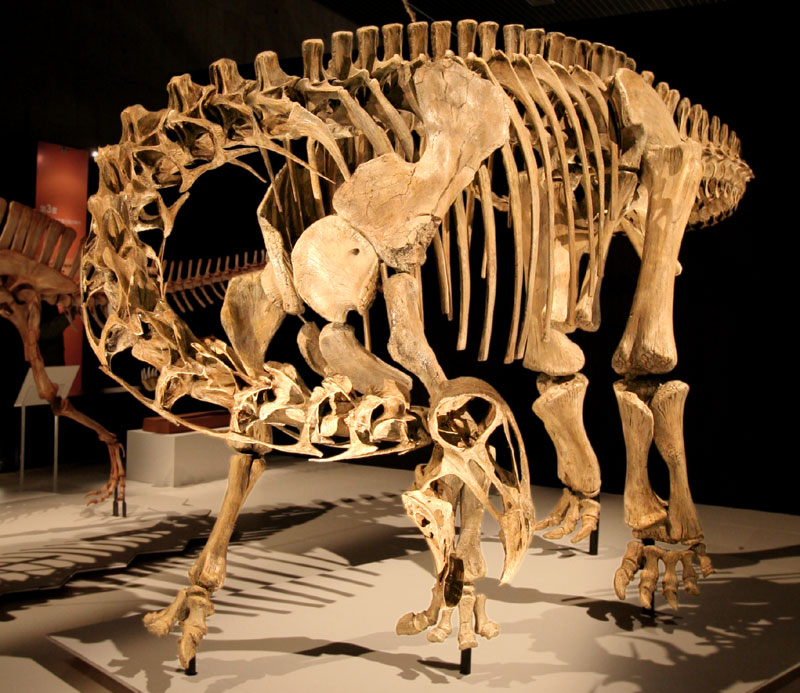Nigersaurus

Nigersaurus is a genus of rebbachisaurid sauropod dinosaur that lived during the middle Cretaceous period, about 115 to 105 million years ago. It was discovered in the Elrhaz Formation in an area called Gadoufaoua, in the Republic of Niger. Fossils of this dinosaur were first described in 1976, but it was only named Nigersaurus taqueti in 1999, after further and more complete remains were found and described. The genus name means "Niger reptile", and the specific name honours the French palaeontologist Philippe Taquet, who discovered the first remains.
Nigersaurus was 9 metres (30 feet) long, which is small for a sauropod, and had a short neck. It weighed around four tonnes, comparable to a modern elephant. Its skeleton was highly pneumatised (filled with air spaces connected to air sacs), but the limbs were robustly built. Its skull was very specialised for feeding, with large fenestrae and thin bones. It had a wide muzzle filled with more than 500 teeth, which were replaced at a rapid rate: around every 14 days. The jaws may have borne a keratinous sheath. Unlike other tetrapods, the tooth-bearing bones of its jaws were rotated transversely relative to the rest of the skull, so that all of its teeth were located far to the front.
The closest relatives of Nigersaurus are grouped within the subfamily Nigersaurinae of the family Rebbachisauridae, which is part of the sauropod superfamily Diplodocoidea. Nigersaurus was probably a browser, and fed with its head close to the ground. The region of its brain that detected smell was underdeveloped, although its brain size was comparable to that of other dinosaurs. There has been debate on whether its head was habitually held downwards, or horizontally like other sauropods. It lived in a riparian habitat, and its diet probably consisted of soft plants, such as ferns, horsetails, and angiosperms. It is one of the most common fossil vertebrates found in the area, and shared its habitat with other dinosaurian megaherbivores, as well as large theropods and crocodylomorphs.
Like all sauropods, Nigersaurus was a megafaunal quadruped with a small head, thick hind legs, and a prominent tail. Among that clade, Nigersaurus was fairly small, with a body length of only 9 m (30 ft) and a femur reaching only 1 m (3 ft 3 in). It may have weighed around four tonnes, comparable to a modern elephant. It had a short neck for a sauropod, with thirteen cervical vertebrae. Nearly all rebbachisaurids had relatively short necks and a length of 10 m (33 ft) or less. The only member of the family that reached the size of larger sauropods was Rebbachisaurus.
The skull of Nigersaurus was delicate, with the four side fenestrae (openings in the skull) larger than in other sauropodomorphs. The total area of bone connecting the muzzle to the back of the skull was only 1.0 cm2(0.16 sq in). These connecting struts of bones were usually less than 2 mm (0.08 in) thick. Despite this, the skull was resistant to the sustained shearing of the teeth. Another unique trait it had among sauropodomorphs was a closed supratemporal fenestra. The nasal openings, the bony nostrils, were elongated. Though the nasal bones are not completely known, it appears the front margin of the bony nostril was closer to the snout than in other diplodocoids. The snout was also proportionately shorter, and the tooth row was not at all prognathous, the snout tip not protruding relative to the remainder of the tooth series. The maxillary tooth row was in its entirety transversely rotated, its normal rear 90° everted towards the front. This was matched by an identical rotation of the dentary of the lower jaw. As a result, no other tetrapod had all of its teeth located as far to the front as Nigersaurus.
Nigersaurus was named and described in more detail by Sereno and colleagues only in 1999, based on remains of newly found individuals. The same article also named Jobaria, another sauropod from Niger. The genus name Nigersaurus ("Niger reptile") is a reference to the country where it was discovered, and the specific name taqueti honours Taquet, who was the first to organise large-scale palaeontological expeditions to Niger. The holotype specimen (MNN GAD512) consists of a partial skull and neck. Limb material and a scapula found nearby were also referred to the same specimen. These fossils are housed at the National Museum of Niger.
The remains of Nigersaurus were initially described in 1976 as belonging to a dicraeosaurid, but in 1999 Sereno's team reclassified it as a rebbachisaurid diplodocoid. Rebbachisauridae is the basalmost family within the superfamily Diplodocoidea, which also contains the long-necked diplodocids and the short-necked dicraeosaurids. The subfamily Nigersaurinae, which includes Nigersaurus and closely related genera, was named by John A. Whitlock in 2011.
Nigersaurus is known from the Elrhaz Formation of the Tegama Group in an area called Gadoufaoua, located in Niger. It is one of the most commonly found vertebrates in the formation. The Elrhaz Formation consists mainly of fluvial sandstones with low relief, much of which is obscured by sand dunes. The sediments are coarse- to medium-grained, with almost no fine-grained horizons. Nigersaurus lived in what is now Niger about 115 to 105 million years ago, during the Aptian and Albian ages of the mid-Cretaceous. It likely lived in habitats dominated by inland floodplains (a riparian zone).
Source: https://en.wikipedia.org / www.natgeo.com











